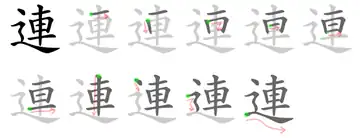連
| ||||||||
 | ||||||||
| ||||||||
Translingual
| Stroke order | |||
|---|---|---|---|
 | |||
Han character
連 (Kangxi radical 162, 辵+7, 10 strokes, cangjie input 卜十田十 (YJWJ), four-corner 35300, composition ⿺辶車)
References
- KangXi: page 1259, character 1
- Dai Kanwa Jiten: character 38902
- Dae Jaweon: page 1747, character 1
- Hanyu Da Zidian (first edition): volume 6, page 3836, character 1
- Unihan data for U+9023
- Unihan data for U+F99A
Chinese
| trad. | 連 | |
|---|---|---|
| simp. | 连* | |
Glyph origin
Characters in the same phonetic series (連) (Zhengzhang, 2003)
Ideogrammic compound (會意) : 辶 (“to walk”) + 車 (“chariot”) – man-drawn carriage.
According to Duan Yucai, 聯/联 (lián) and 連 are two characters for a same word, with the former used in the Zhou dynasty and the latter in the Han dynasty.
Etymology 1
From Proto-Sino-Tibetan *s-rjan (“equal; to place in a row; to align; row”); related to 聯 (OC *ɡ·ron) (STEDT; Schuessler, 2007).
Pronunciation
Definitions
連
- (historical) man-drawn carriage
- to link; to join; to connect
- to ally with; to unite
- to involve; to implicate
- to simultaneously gain
- to include; including; counting
- continuously; successively; one after one; repeatedly
- from; counting from
- and; with
- together; with each other
- hard; difficult; tough
- full; entire; whole
- (used in the 連…都/也… structures for emphasis) even; paradoxically
- affinity; relationship by marriage
- (military) company (consisting of platoons (排) and forming part of a battalion (營))
- 他以為新兵連都是“刀光劍影”“舞槍弄棒”的生活,沒想到卻是三點一線的固定生活模式和枯燥乏味的訓練內容。 [MSC, trad.]
- Tā yǐwèi xīnbīng lián dōu shì “dāo guāng jiàn yǐng” “wǔ qiāng nòng bàng” de shēnghuó, méi xiǎngdào què shì sāndiǎnyīxiàn de gùdìng shēnghuó móshì hé kūzào fáwèi de xùnliàn nèiróng. [Pinyin]
- He thought that life in a company made up of new recruits would be filled with exciting maneuvers, but he did not expect it to be a monotonous routine with boring training content.
他以为新兵连都是“刀光剑影”“舞枪弄棒”的生活,没想到却是三点一线的固定生活模式和枯燥乏味的训练内容。 [MSC, simp.]
- (grammar) Short for 連詞/连词 (liáncí, “conjunction”).
- a surname
Synonyms
- (to link):
- (to include):
Synonyms of 連
- (continuously):
Synonyms of 連
- (even):
Compounds
Derived terms from 連
|
|
|
Pronunciation
Pronunciation
Pronunciation
Definitions
連
- Only used in 連石/连石.
Japanese
| Shinjitai | 連 | |
| Kyūjitai [1] |
連 連or 連+ ︀? |
 |
| 連󠄀 連+ 󠄀?(Adobe-Japan1) | ||
| 連󠄃 連+ 󠄃?(Hanyo-Denshi) (Moji_Joho) | ||
| The displayed kanji may be different from the image due to your environment. See here for details. | ||
Readings
- Go-on: れん (ren, Jōyō)
- Kan-on: れん (ren, Jōyō)
- Kun: つらなる (tsuranaru, 連なる, Jōyō); つらねる (tsuraneru, 連ねる, Jōyō); つれる (tsureru, 連れる, Jōyō); つがり (tsugari, 連); つるみ (tsurumi, 連み); つるむ (tsurumu, 連む); つれ (tsure, 連れ); づれ (zure, 連れ); むらじ (muraji, 連)
- Nanori: つぎ (tsugi); つら (tsura); まさ (masa); むらじ (muraji); やす (yasu)
Compounds
- 連関 (renkan): linkage
- 連休 (renkyū): consecutive holidays
- 連結 (renketsu): linking
- 連呼 (renko): calling again and again
- 連行 (renkō): taking
- 連衡 (renkō): alliance
- 連合 (rengō): union
- 連鎖 (rensa) chain
- 連座 (renza): implication
- 連載 (rensai): series
- 連日 (renjitsu): everyday
- 連声 (renjō): sandhi
- 連想 (rensō): association of ideas
- 連続 (renzoku): continuous
- 連濁 (rendaku): rendaku, sequential voicing
- 連中 (renchū): party
- 連動 (rendō): linked action
- 連盟 (renmei): league
- 連絡 (renraku): contact
- 連理 (renri): trees with intertwined branches; relationship between spouses
- 関連 (kanren): relation
- 連係 (renkei): linkage
- 連珠 (renju)
- 連邦 (renpō): commonwealth
- 連立 (renritsu): coalition
- 連弾 (rendan): barrage
- 六連星 (mutsuraboshi): Pleiades
Etymology 2
| Kanji in this term |
|---|
| 連 |
| むらじ Grade: 4 |
| nanori |
Old Japanese [Term?], from 村 (mura, “village”) + 主 (nushi, “chief”)
Proper noun
連 • (Muraji)
- (historical) the second-lowest of the 八色の姓 (Yakusa no Kabane, “eight hereditary titles promulgated by Emperor Tenmu”) [from 675 CE]
See also
- 姓 (kabane)
- 村主 (suguri)
References
- “連”, in 漢字ぺディア (Kanjipedia) (in Japanese), 日本漢字能力検定協会, 2015—2023
Korean
Hanja
連 (eumhun 잇닿을 련 (itda'eul ryeon), South Korea 잇닿을 연 (itda'eul yeon))
Compounds
- 연속 (連續, yeonsok, “continuation; succession”)
Vietnamese
This article is issued from Wiktionary. The text is licensed under Creative Commons - Attribution - Sharealike. Additional terms may apply for the media files.